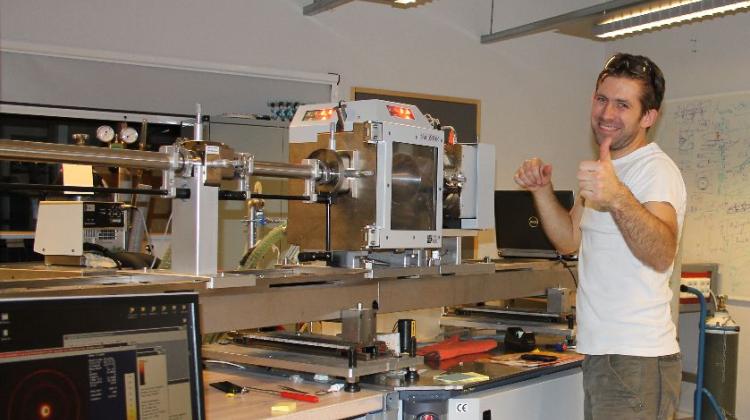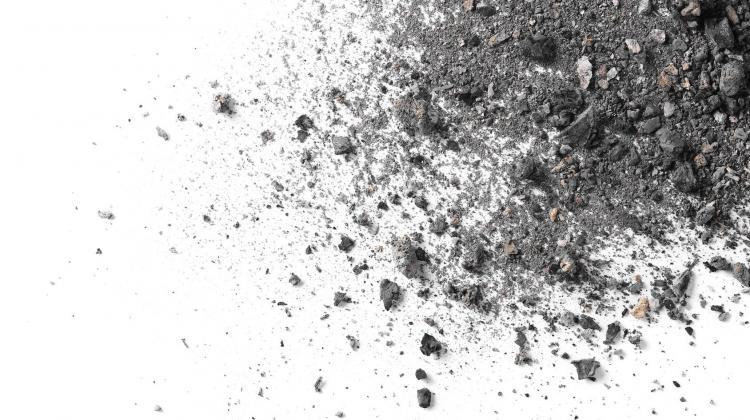Clay: the future of CO2 storage?
 Dr. Zbigniew Rozynek in the NTNU university laboratory. Source: Zbigniew Rozynek
Dr. Zbigniew Rozynek in the NTNU university laboratory. Source: Zbigniew Rozynek
Properly prepared synthetic clay can be an effective and cheap material allowing to capture and store greenhouse gas, carbon dioxide, research of an international team of scientists indicates.
"Scientists are looking for ways to easily, cheaply and effectively capture and store carbon dioxide (CO2) particles. To that end, they are testing a variety of materials, including clay, to be more precise, clay materials, which are its main component" - explained in an interview with PAP Dr. Zbigniew Rozynek, a physicist from the Polish Academy of Sciences, who during his postdoctoral fellowship in Norway (NTNU-Trondheim) conducted research on adsorption and desorption of CO2 in clay materials.
In the future, the ability to capture CO2 may be crucial for combating greenhouse gas emissions.
"Recent studies indicate that the so-called clay material, which is the main component of natural clay - well known material, abundantly present in the natural environment - may be as good as other, more advanced, but expensive materials. The greatest benefit of using clay materials is their availability, which directly translates into lower cost" - explained Dr. Rozynek.
Currently, experts worldwide investigate which type of material is best suited for the process of CO2 sorption. At the same time, they are looking for methods to reuse CO2, or capture and store it until we learn to use it in the future. One idea is to store CO2 in various materials, such as clay - explained the physicist.
Research in this area with promising results has been conducted by an international team of scientists led by Prof. Jon Otto Fossum from the Department of Physics at the Norwegian University of Science and Technology (NTNU) in Trondheim. The results have been presented in "Scientific Reports" of Nature publishing group, first author of the publication was Leander Michels from NTNU.
In their research, the scientists focused on smectite - synthetic clay material produced in the lab, used, among others, in the production of hand creams and toothpaste. "Smectite meets virtually all conditions necessary to be regarded as a good material for storing CO2. It is cheap, suitable for re-use and, most importantly, it is a porous material with a very high specific surface area, which means that it can adsorb a huge the number of particles" - emphasised Zbigniew Rozynek.
Smectite (like other clay materials) is a layer-type material: it consists of a number of very thin crystalline layers with thickness below than 1 nanometer, superimposed on each other. "A bit like a deck of cards or a book, in which there are small voids between pages. This layer structure makes the surface adsorption of smectite many times greater compared to other materials with the same volume but a more uniform structure. The surface of each of these thin layers has negative charges, and between the layers are positively charged ions (cations) which serve as a +glue+ that binds the thin layers" - said Dr. Rozynek.
One of the mechanisms due to which carbon dioxide can be sorbed in smectite is the fact that it can bind with cations.
New studies have shown that the type of cations in smectite affect the dynamics of CO2 capture by this material, as well as the temperature above which CO2 molecules are released. In practice, this means that properly prepared synthetic clay absorbs and releases gas more quickly, and by selecting the correct type of cations the process can be performed faster and cheaper.
The researchers came to their conclusions by testing smectites with three types of cations: lithium, sodium and nickel. "We noticed that when we replace the type of ions between the crystalline layers, the dynamics of binding and release of carbon dioxide also changes. If, for example, lithium ions are present in the clay, at the same temperature and pressure carbon dioxide is absorbed much faster than if we used clay with sodium cations, for example" – said the physicist.
Since the beginning of the industrial revolution in the mid-nineteenth century the concentration of carbon dioxide in the atmosphere has been increasing at an unprecedented rate. Scientists say that human activity, e.g. the burning of fossil fuels, is responsible for most of this increase. The capability to capture carbon dioxide may in the future prove crucial in the fight against greenhouse gas emissions.
"What our group was involved in is typical basic research leading to the understanding of the properties of a system. A lot of research is carried out starting with a simplified system. Here, this simplification was to eliminate water (humidity) that is normally present between the layers of crystalline smectite and that can change the course of the process and the behaviour of cations. It is still a long road to direct applications. But I\'m glad that I could take part in such an interesting research project and contribute"- added Zbigniew Rozynek.
PAP - Science and Scholarship in Poland, Anna Ślązak
zan/ agt/ mrt/
tr. RL
Przed dodaniem komentarza prosimy o zapoznanie z Regulaminem forum serwisu Nauka w Polsce.

















